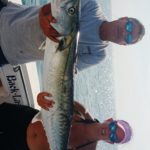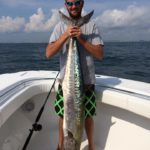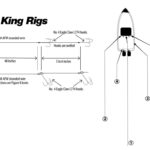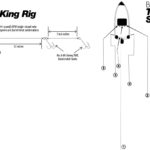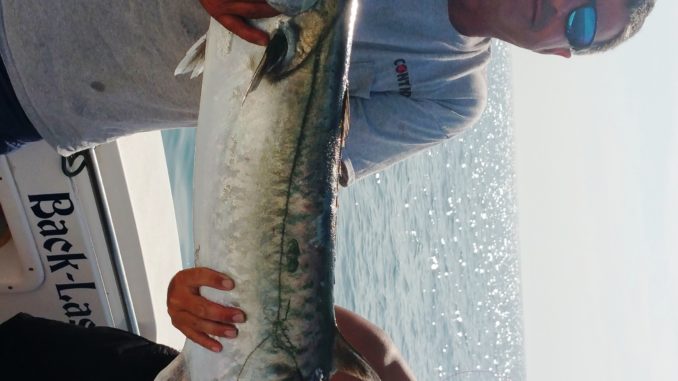
Fall brings some of the biggest kings and some of the best action to the North Carolina coast. Two Sneads Ferry fishermen share their tricks.
Fall king mackerel fishing along the North Carolina coast is on a par with anywhere. Between the Virginia and South Carolina state lines, there are plenty of fishermen chasing kings every day the weather allows, and there are king mackerel tournaments every weekend, sometimes several.
In the middle of Onslow Bay, about halfway from Virginia to South Carolina, the sleepy fishing village of Sneads Ferry is just a few miles inside sometimes troublesome New River Inlet. The village is not incorporated, and the population is small, but in the fall of 2015 two Sneads Ferry fishermen led their teams to Southern Kingfish Association national championships and added the legend of North Carolina fishermen being the kings of big kings, while bringing a little recognition to the town.
Last November, SKA’s national championship returned to North Carolina after 15 years in Florida and Mississippi, and boats from North Carolina won two of the three division classes. Capt. Eris Jones, Arthur Hall and Craig Drye of the Backlash won the single-engine championship, and Capt. Kevin Norris, Jordan Norris, Curtis Trexel and David Jones of the Reel Blessed were champions in the small boat class.
Jones and Norris like their Sneads Ferry headquarters because the location provides multiple fishing options locally and in both directions.
“Just because we live here, doesn’t mean we don’t keep up with fishing all along the state,” Jones said. “Information is vital to king fishing, especially tournament king fishing, and with unlimited cell-phone plans, I talk with fishermen along the coast every week. It isn’t always about finding out where the fish are, but sometimes it’s where they aren’t. It’s just as important to eliminate unproductive spots as it is to find out where the fish are. You save running around time and can fish a productive area longer. My little Contender is very seaworthy, but we’re slower than the big boats and have to leave earlier to make the scales. It’s especially important to us to spend our time fishing in a good location.”
“Confidence in what you are doing is as important as anything else,” Norris said. “Whether it’s confidence in where you’re fishing, your bait or your equipment, you’re at your best when not questioning anything. We’ve always felt good about our information, but had a stretch a few years ago when we were having rigs break — I mean a lot of rigs were breaking. We threw away all the wire we had and bought new wire.
“There must have been a batch of bad wire that year, because the new wire broke too easily too,” Norris said. “We were getting a little spooked, especially if a fish made a long and hard first run and appeared to be a big fish. We lost several more and had a near miss with a really big fish when the wire broke as we were reaching to gaff it.
“Jordan had been saying we should try some seven strand wire, and at this point I told him to get some and make some rigs, that it couldn’t be any worse,” Norris said. “He bought some AFW stranded wire in 40- and 60-pound ratings, and we’ve been using it since. We’ve only had the stranded wire break one time, and it appeared the fish bit through it.”
Wire and rigs are two subjects where Jones and Norris differ, and it proves the point about there being more than one way to catch king mackerel. Jones uses No. 5, single-strand wire, with approximately 5 to 6 inches between a pair of No. 6, 4X strong VMC treble hooks in black-nickel finish and with only a foot of leader in front of the nose hook. He uses a Spro 50-pound swivel at the end to tie the line from the reel.
The Reel Blessed rig begins with a 5-foot piece of 40- or 60- pound AFW stranded wire. Two No. 4, Eagle Claw 4X strong, treble hooks are added at one end about 5 to 6 inches apart and a Spro 50-pound swivel at the other end. Most of their seven-strand wire rigs are tied using Figure 8 knots, but Jordan Norris also makes some that snell the hooks in place and use a Figure 8 knot to attach the swivel.
With information on the location of the fish and a bunch of rigs ready to go, bait is the next link. The Backlash and Reel Blessed teams may use five live baits and three dead baits, all of them at any time. The question then is, how do they use them? These two teams set their tables a little differently, but their catches bear out that each approach works. In the 2015 SKA national championship, both techniques and tactics produced large fish in the same area on back-to-back days.
Norris and crew primarily rely on surface baits, typically running five lines — four if conditions are difficult — at different distances behind the boat. Norris rarely uses downriggers and has discussed not carrying them to keep the gunwales clear. They often have different baits on several lines, but all are trolled on top. If the fish aren’t hitting their usual spread, they’ll drop a bait or two down using the downriggers, but they do this primarily in the afternoons, once the sun is up in the sky and the day is bright.
Jones and crew also typically set a spread using five lines. If conditions are excellent or the bite is slow, they will sometimes add a sixth line to give the mackerel another chance to spot a bait. The Backlash spread includes three surface lines and two downrigger lines, with another surface line being the sixth. The surface lines are at staggered lengths behind the boat, and the downrigger lines are at different depths.
Norris and Jones agree on lighter drags to subdue king mackerel. The small live baits require small hooks to prevent injuring or killing them, and using too much drag often results in pulled hooks and missed fish. The light tips on their kingfish rods keep pressure on the fish at all times and this is the key to wearing them down.
DESTINATION INFORMATION
HOW TO GET THERE — Sneads Ferry is at the intersection of the New River and Intracoastal Waterway in Onslow County. Best access is from US 17 between Wilmington and Jacksonville, to NC 210 or NC 172, then to Sneads Ferry. N.C. Wildlife Commission boat ramps are on SR 1557 at Fulcher’s Landing and under the NC 210 bridge on the Topsail Island side of the ICW. New River Marina on the ICW and Safe Haven Marina and RV Park on the New River are popular fee ramps.
WHEN TO GO — King mackerel are present in the waters off the central North Carolina coast from May through November. The peak begins in September and continues through October. A few spots off Topsail Island occasionally hold large kings, but excellent fishing is on the western edge of Onslow Bay toward Cape Fear and the western edge of Raleigh Bay to the east across Cape Lookout shoals.
BEST TECHNIQUES — For tackle, 7-foot, medium-light conventional rods in live-bait taper are preferred. Popular reels linclude Penn GS 545s, Shimano Speedmaster TSM-IVs and Avet 6.0s. Spool up with 20-pound mono. Live bait rigs are the norm, with menhaden, mullet and bluefish the most-popular baits. Ribbonfish are a very productive dead bait on special rigs.
FISHING INFO/GUIDES — Eris Jones, Backlash Fishing Charters, 910-340-3386, www.facebook.com/Team.backlashfishing/?fref=ts); New River Marina, 910-327-2106, www.newrivermarina.com; East Coast Sports, 910-328-1887, www.eastcoastsports.com. See also Guides and Charters in Classifieds.
ACCOMMODATIONS — Quality Inn, Sneads Ferry, 910-327-8282, Seward Inn, 910-347-0469, www.theseawardinn.com; Topsail Shores Inn, 910-685-0969, www.topsailshoreinn.com; Onslow County Tourism, www.onslowcountytourism.com.
MAPS — Capt. Segull’s Nautical Charts, 888-473-4855, www.captainsegullcharts.com; Sealake Fishing Guides, 800-411-0185, www.thegoodspots.com; Maps Unique, 910-458-9923, www.offshore-fishing-map.com; The Grease Chart, 252-560-6527, www.greasechart.com.

